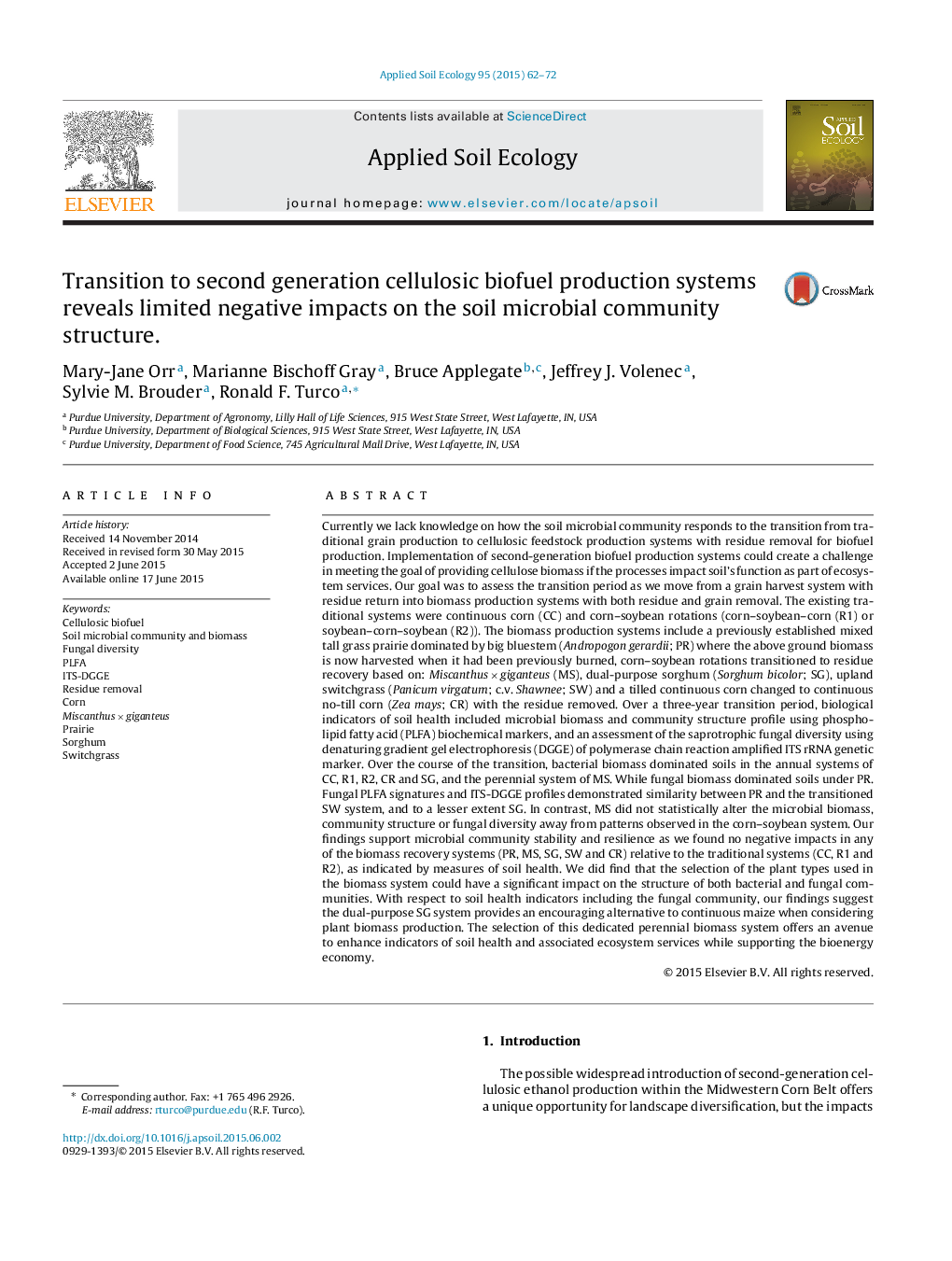| کد مقاله | کد نشریه | سال انتشار | مقاله انگلیسی | نسخه تمام متن |
|---|---|---|---|---|
| 4381936 | 1617788 | 2015 | 11 صفحه PDF | دانلود رایگان |
• During the transition from corn–soybean rotation to biomass production, no negative impacts on soil health were found for any of the residue recovery plant biomass systems.
• The selection of the biomass plant types could impact the structure of both bacterial and fungal communities.
• With respect to soil health, dual-purpose sorghum for biomass provides an encouraging alternative to continuous maize.
• The selection of a dedicated perennial biomass system, over an annual system, offers an avenue to enhance indicators of soil health and associated ecosystem services while supporting the bioenergy economy.
Currently we lack knowledge on how the soil microbial community responds to the transition from traditional grain production to cellulosic feedstock production systems with residue removal for biofuel production. Implementation of second-generation biofuel production systems could create a challenge in meeting the goal of providing cellulose biomass if the processes impact soil's function as part of ecosystem services. Our goal was to assess the transition period as we move from a grain harvest system with residue return into biomass production systems with both residue and grain removal. The existing traditional systems were continuous corn (CC) and corn–soybean rotations (corn–soybean–corn (R1) or soybean–corn–soybean (R2)). The biomass production systems include a previously established mixed tall grass prairie dominated by big bluestem (Andropogon gerardii; PR) where the above ground biomass is now harvested when it had been previously burned, corn–soybean rotations transitioned to residue recovery based on: Miscanthus × giganteus (MS), dual-purpose sorghum (Sorghum bicolor; SG), upland switchgrass (Panicum virgatum; c.v. Shawnee; SW) and a tilled continuous corn changed to continuous no-till corn (Zea mays; CR) with the residue removed. Over a three-year transition period, biological indicators of soil health included microbial biomass and community structure profile using phospholipid fatty acid (PLFA) biochemical markers, and an assessment of the saprotrophic fungal diversity using denaturing gradient gel electrophoresis (DGGE) of polymerase chain reaction amplified ITS rRNA genetic marker. Over the course of the transition, bacterial biomass dominated soils in the annual systems of CC, R1, R2, CR and SG, and the perennial system of MS. While fungal biomass dominated soils under PR. Fungal PLFA signatures and ITS-DGGE profiles demonstrated similarity between PR and the transitioned SW system, and to a lesser extent SG. In contrast, MS did not statistically alter the microbial biomass, community structure or fungal diversity away from patterns observed in the corn–soybean system. Our findings support microbial community stability and resilience as we found no negative impacts in any of the biomass recovery systems (PR, MS, SG, SW and CR) relative to the traditional systems (CC, R1 and R2), as indicated by measures of soil health. We did find that the selection of the plant types used in the biomass system could have a significant impact on the structure of both bacterial and fungal communities. With respect to soil health indicators including the fungal community, our findings suggest the dual-purpose SG system provides an encouraging alternative to continuous maize when considering plant biomass production. The selection of this dedicated perennial biomass system offers an avenue to enhance indicators of soil health and associated ecosystem services while supporting the bioenergy economy.
Journal: Applied Soil Ecology - Volume 95, November 2015, Pages 62–72
